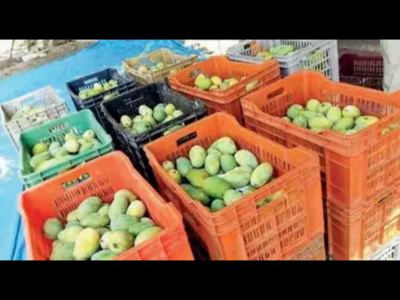- News
- City News
- surat News
- Gujarat: Hafoos gets a worthy successor in Sonpari
Gujarat: Hafoos gets a worthy successor in Sonpari

Hafoos mangos in Gujarat market
SURAT: Herald the new queen, Sonpari, who will soon rule mango lovers’ taste buds. With South Gujarat’s signature, the Hafoos variety, slowly losing its tag and kingdom to Kesar owing to changing weather patterns, this new variety that smells and tastes exactly like Alphonso, but only bigger in and better, is emerging as the the worthy successor.
What’s more, it lasts longer too, claims agriculturists in the region.
Named ‘Sonpari’ after the ripened fruit’s golden hue, the mango was developed at Pariya research centre of Navsari Agriculture University. Scientists developed the new breed through cross grafting of Valsadi Hafoos and south India’s popular Banganapalli.
Initial research work started 20 years ago and farmers are now literally enjoying the fruits of the hard labour. In the last eight years, 14,000 saplings of Sonpari were distributed among farmers. Considering 50% rate of survival, at least 4,000 to 5,000 trees have started bearing fruits.
Alphonso and Kesar mango trees, which are a decade old, bear 100 to 150 kilograms of mangoes. But Sonpari trees managed to produce more than these two varieties!
“Alphonso has few problems — one is of white spongy tissues in the fruit, and then, its extreme sensitivity to weather inclemencies, besides bearing fruits in alternate years. However, this breed overcomes all these problems and yet looks and tastes like Alphonso and in fact, some of its fruits are sweeter than Alphonso and Kesar,” said Dr C K Timbadiya, senior scientist at NAU.
Sonpari’s advantages are not just limited to size and sweetness, but its longevity is even more than Kesar and Alphonso. Agriculturists see a huge potential of exports of Sonpari in coming years.
“The fruits lasts longer than Kesar and Alphonso as even after 14 days it does not rot,” said Dr Chirag Patel, associate research scientist (Horticulture) at Pariya research centre.
“Right now, the production is low because the trees are still young, but customers like its taste so much that they I have already started getting inquiry for next season,” said Girish Patel, a farmer from Jalalpore taluka of Navsari. He added that due to its high demand, farmers are selling it for as high as Rs 3,500 for 20 kilograms, more than double the market price of Alphonso and Kesar.
What’s more, it lasts longer too, claims agriculturists in the region.
Named ‘Sonpari’ after the ripened fruit’s golden hue, the mango was developed at Pariya research centre of Navsari Agriculture University. Scientists developed the new breed through cross grafting of Valsadi Hafoos and south India’s popular Banganapalli.
Initial research work started 20 years ago and farmers are now literally enjoying the fruits of the hard labour. In the last eight years, 14,000 saplings of Sonpari were distributed among farmers. Considering 50% rate of survival, at least 4,000 to 5,000 trees have started bearing fruits.
Alphonso and Kesar mango trees, which are a decade old, bear 100 to 150 kilograms of mangoes. But Sonpari trees managed to produce more than these two varieties!
“Alphonso has few problems — one is of white spongy tissues in the fruit, and then, its extreme sensitivity to weather inclemencies, besides bearing fruits in alternate years. However, this breed overcomes all these problems and yet looks and tastes like Alphonso and in fact, some of its fruits are sweeter than Alphonso and Kesar,” said Dr C K Timbadiya, senior scientist at NAU.
Sonpari’s advantages are not just limited to size and sweetness, but its longevity is even more than Kesar and Alphonso. Agriculturists see a huge potential of exports of Sonpari in coming years.
“The fruits lasts longer than Kesar and Alphonso as even after 14 days it does not rot,” said Dr Chirag Patel, associate research scientist (Horticulture) at Pariya research centre.
“Right now, the production is low because the trees are still young, but customers like its taste so much that they I have already started getting inquiry for next season,” said Girish Patel, a farmer from Jalalpore taluka of Navsari. He added that due to its high demand, farmers are selling it for as high as Rs 3,500 for 20 kilograms, more than double the market price of Alphonso and Kesar.
FacebookTwitterLinkedinEMail
Start a Conversation
end of article
Quick Links
Delhi Air PollutionDelhi TemperatureChennai WeatherBangalore TemperatureCovid vaccination centres in DelhiCoronavirus in DelhiRTPCR test in GurgaonHyderabad RainPollution level in BangaloreDelhi SmogDelhi TemperatureNoida AQIGurgaon AQI todayFire in MumbaiMumbai RainsCovid 19 RT PCR Test in NoidaDelhi AQI todaySrinagar encounter
